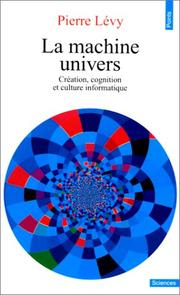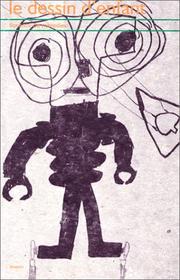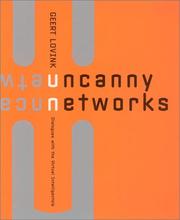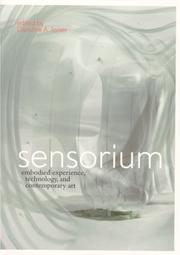| Listing 1 - 9 of 9 |
Sort by
|
Book
ISBN: 377010725X Year: 1974 Publisher: Köln : DuMont Schauberg,
Abstract | Keywords | Export | Availability | Bookmark
 Loading...
Loading...Choose an application
- Reference Manager
- EndNote
- RefWorks (Direct export to RefWorks)
Aesthetics. --- Cybernetics. --- CYBERNETIQUE --- ART MODERNE --- INFORMATION, THEORIE DE L', EN ESTHETIQUE --- 20E SIECLE
Book
ISBN: 2852060698 2852060728 2852060701 9782852060722 Year: 1980 Volume: 3 Publisher: Paris : Technique et documentation = Tec & Doc,
Abstract | Keywords | Export | Availability | Bookmark
 Loading...
Loading...Choose an application
- Reference Manager
- EndNote
- RefWorks (Direct export to RefWorks)
Process control. --- Engineering instruments. --- Contrôle industriel --- Ingénierie --- Instruments --- Instrumentation (Cybernetique) --- Ingénierie --- Ingénierie - Instruments

ISBN: 9782020130929 2020130920 Year: 1987 Publisher: Paris Seuil
Abstract | Keywords | Export | Availability | Bookmark
 Loading...
Loading...Choose an application
- Reference Manager
- EndNote
- RefWorks (Direct export to RefWorks)
La " machine univers ", c'est bien sûr l'ordinateur, qui semble enfin réaliser ce vieux rêve de l'humanité : celui d'une machine universelle, capable de tout calculer. Mais aussi bien plus que cela : car l'informatisation de la société fait émerger une nouvelle vision du monde, conçu comme un univers où tout serait calculable. C'est à cette véritable mutation anthropologique, comparable seulement à celle qui accompagna l'apparition de l'écriture, que Pierre Lévy s'intéresse dans ce livre profondément original. A partir d'une vaste enquête sur les nouvelles conditions technique de la création (picturale, musicale et scientifique), l'auteur dessine les lignes de force de la culture qui vient. Il montre que les simulations numériques et la mise en algorithmes des raisonnements scientifiques amènent à considérer les objets physiques, biologiques, et même les sujets humains, comme de simples systèmes de traitement de l'information, en effaçant cette partie essentielle du réel et de la culture qui ne sera jamais réductible par le calcul. MAis il montre aussi que la transformation contemporaine des manières de saisir la réalité, loin d'être une simple conséquence de l'informatisation, plonge de profondes racines dans a culture occidentale : elle apparaît comme le couronnement d'un processus multiséculaire, qui a lentement substitué la domination du calcul à celle du langage.
Anthropologie --- Civilisation --- Créativité --- Cybernétique --- Informatique --- Intelligence artificielle --- 82:62 --- 82:62 Literatuur en technologie --- Literatuur en technologie

ISBN: 2907784048 9782907784047 290778403X 9782907784030 Year: 1990 Publisher: Paris : Blusson,
Abstract | Keywords | Export | Availability | Bookmark
 Loading...
Loading...Choose an application
- Reference Manager
- EndNote
- RefWorks (Direct export to RefWorks)
Marcus, Aaron ; Roy, John ; Yamanaka), CTG (Komura & ; Nees, Georg ; Lecci, Auro ; Nake, Frieder ; Vasarely, Victor ; Francke, Herbert W. ; Molnar, Vera ; Mohr, Manfred ; Ridell, Torsten ; Knowlton, Ken ; Swartz, Lilian ; Colonna, Jean François ; Norton, Alan ; Wender, Monique ; de Senneville, Elisabeth ; Colonna, J-F ; Schwarz, Lilian ; Vasulka, Steina & Woody ; Latham, William ; Höhne, K.H. ; NCSA (University of Illinois) ; Cirad ; Kawaguchi, Yiochiro ; Hill, G. ; Sims, Karl ; Logue, John ; Paik, Nam June ; Renault ; Oliver, Vaughan ; Fukomoto, Omura
Information theory --- Théorie de l'information --- Dessin d'enfant --- Psychanalyse --- Psychologie --- Représentation de l'espace --- Analyse de l'art --- Art --- Cinéma --- Communication --- Cybernétique --- Esthétique --- Image de synthèse --- Informatique appliquée --- Informatique graphique --- Littérature --- Média --- Musique --- Processus de création --- Klee, Paul --- Théorie de l'information
Book
ISBN: 9052403899 9068015265 Year: 1996 Publisher: Antwerpen Hadewijch
Abstract | Keywords | Export | Availability | Bookmark
 Loading...
Loading...Choose an application
- Reference Manager
- EndNote
- RefWorks (Direct export to RefWorks)
kunstfilosofie --- Computer. Automation --- philosophy of art --- Sociology of culture --- cybercultuur --- cultuurfilosofie --- Cybernetica --- Cybernétique --- 316.7 --- #SBIB:309H040 --- #SBIB:309H1016 --- #SBIB:309H1720 --- 316.42 --- #A9703A --- Mark Dery --- nieuwe media --- computers --- technologie --- kunst --- lichamelijkheid --- Stelarc --- seksualiteit --- cyberseks --- kunst en technologie --- 791.5 --- Cultuursociologie --(algemeen) --- Populaire cultuur algemeen --- Media: socio-culturele aspecten (massamedia en maatschappij, met inbegrip van cultuurhistorische werken en werken over de maatschappelijke en politieke effecten van de (diverse) media) --- Informatiekunde, informatie management --- Social change. Sociale ontwikkeling. Sociale veranderingen. Modernisering. Evolutie .Sociale revolutie. Modernisme --- 316.42 Social change. Sociale ontwikkeling. Sociale veranderingen. Modernisering. Evolutie .Sociale revolutie. Modernisme --- 316.7 Cultuursociologie --(algemeen) --- 670 --- informatica --- internet --- informatique
Book
ISBN: 9780854882342 9780262527194 0262527197 Year: 2015 Volume: Systems Publisher: London Whitechapel Gallery Ventures Limited
Abstract | Keywords | Export | Availability | Bookmark
 Loading...
Loading...Choose an application
- Reference Manager
- EndNote
- RefWorks (Direct export to RefWorks)
In the late 1950s, experiments such as the cybernetic sculptures of Nicolas Schöffer or the programmatic music compositions of John Cage and Iannis Xenakis transposed systems theory from the sciences to the arts. By the 1960s, artists as diverse as Roy Ascott, Hans Haacke, Robert Morris, Sonia Sheridan, and Stephen Willats were breaking with accepted aesthetics to embrace open systems that emphasized organism over mechanism, dynamic processes of interaction among elements, and the observer's role as an inextricable part of the system. Jack Burnham's 1968 Artforum essay "Systems Aesthetics" and his 1970 "Software" exhibition marked the high point of systems-based art until its resurgence in the changed conditions of the twenty-first century. Systems traces this radical shift in aesthetics from its roots in mid twentieth-century general systems theory, cybernetics, and artificial intelligence to the cutting-edge science of the present. The collected texts examine the connections between advanced technological systems, our bodies and minds; the relation of musical to spatial and architectural structures; and the ways in which systems-based art projects can create self-generating entities and networks, alter our experience of time, change the configurations of social relations, cross cultural borders, and interact with threatened ecosystems.
artificial intelligence --- Aesthetics of art --- hedendaagse kunst --- Philosophy and psychology of culture --- systems [equipment] --- kunstprojecten --- cybernetic art --- Art --- interactive art --- anno 1900-1999 --- Arts, Modern --- System theory. --- Philosophy --- Philosophy. --- 7.01 --- Kunst ; theorie, filosofie, esthetica --- 7.038 --- Kunsttheorie ; systeemtheorie en kunst in de 20ste eeuw --- Kunstgeschiedenis ; 1950 - 2000 --- System theory --- Esthétique --- Technologie --- Technologie et art --- Cybernétique --- Intelligence artificielle --- Cultuurfilosofie. Cultuurpsychologie --- Kunstesthetica --- Kunst --- cybernetische kunst --- kunstmatige intelligentie --- systemen --- interactieve kunst --- systeemtheorie --- cybernetica --- epistemologie --- kennisleer --- mediatheorie --- mediakunde --- information design --- informatiedesign --- informatie --- kunst --- 130.2 --- 7.039 --- 7.038/039 --- cultuurfilosofie --- kunsttheorie --- twintigste eeuw --- eenentwintigste eeuw --- KI (kunstmatige intelligentie) --- projects [artistic concepts] --- AI (artificiële intelligentie)

ISBN: 0262122510 9780262621878 Year: 2002 Publisher: Cambridge MIT
Abstract | Keywords | Export | Availability | Bookmark
 Loading...
Loading...Choose an application
- Reference Manager
- EndNote
- RefWorks (Direct export to RefWorks)
For Geert Lovink, interviews are imaginative texts that can help to create global, networked discourses not only among different professions but also among different cultures and social groups. Conducting interviews online, over a period of weeks or months, allows the participants to compose documents of depth and breadth, rather than simply snapshots of timely references.The interviews collected in this book are with artists, critics, and theorists who are intimately involved in building the content, interfaces, and architectures of new media. The topics discussed include digital aesthetics, sound art, navigating deep audio space, European media philosophy, the Internet in Eastern Europe, the mixing of old and new in India, critical media studies in the Asia-Pacific region, Japanese techno tribes, hybrid identities, the storage of social movements, theory of the virtual class, virtual and urban spaces, corporate takeover of the Internet, and the role of cyberspace in the rise of nongovernmental organizations.Interviewees included Norbert Bolz, Paulina Borsook, Luchezar Boyadjiev, Kuan-Hsing Chen, Cãlin Dan, Mike Davis, Mark Dery, Kodwo Eshun, Susan George, Boris Groys, Frank Hartmann, Michael Heim, Dietmar Kamper, Zina Kaye, Tom Keenan, Arthur Kroker, Bruno Latour, Marita Liulia, Rafael Lozano-Hemmer, Peter Lunenfeld, Lev Manovich, Mongrel, Edi Muka, Jonathan Peizer, Saskia Sassen, Herbert Schiller, Gayatri Spivak, János Sugár, Ravi Sundaram, Toshiya Ueno, Tjebbe van Tijen, McKenzie Wark, Hartmut Winkler, and Slavoj Zizek.
Computer networks --- Computers and civilization. --- Cyberspace. --- Information society. --- Information technology --- Internet --- Social aspects. --- Geert Lovink --- grafische vormgeving --- computers --- websites --- webdesign --- communicatie --- kunst en technologie --- digitale communicatie --- nieuwe media --- internet --- interfaces --- digitale esthetica --- kunsttheorie --- esthetica --- Oost-Europa --- Indië --- India --- Japan --- techno --- virtual reality --- virtuele realiteit --- cyberspace --- Kamper Dietmar --- Bolz Norbert --- Heim Michael --- Zizek Slavoj --- Kroker Arthur --- Bulgarije --- Boyadjiev Luchezar --- Spivak Gayatri --- Manovich Lev --- van Tijen Tjebbe --- Sassen Saskia --- Dery Mark --- Schiller Herbert I. --- Chen Kuan-Hsing --- Peizer Jonathan --- Latour Bruno --- Muka Eduard --- Winkler Hartmut --- Davis Mike --- Finland --- GSM --- themaparken --- Liulia Marita --- Keenan Thomas --- lichamelijkheid --- Groys Boris --- Ueno Toshiya --- Sugar Janos --- George Susan --- Hartmann Frank --- relationele architectuur --- relational architecture --- Lozano-Hemmer Rafael --- Wark McKenzie --- Dan Calin --- Borsook Paulina --- Eshun Kodwo --- 791.5 --- 766.01 --- 7.01 --- 130.2 --- Computers and civilization --- Cyberspace --- Information society --- Schiller Herbert I --- Sociology --- Information superhighway --- Space and time --- Computers --- Telematics --- Civilization and computers --- Civilization --- Social aspects --- Intelligence artificielle --- Sociologie de la communication --- Sociologie de la culture --- Cybernétique


ISBN: 9780262101172 0262101173 Year: 2006 Publisher: Cambridge (Mass.): MIT press,
Abstract | Keywords | Export | Availability | Bookmark
 Loading...
Loading...Choose an application
- Reference Manager
- EndNote
- RefWorks (Direct export to RefWorks)
Artists and writers reconsider the relationship between the body and electronic technology in the twenty-first century through essays, artworks, and an encyclopedic "Abecedarius of the New Sensorium."The relationship between the body and electronic technology, extensively theorized through the 1980s and 1990s, has reached a new technosensual comfort zone in the early twenty-first century. In Sensorium, contemporary artists and writers explore the implications of the techno-human interface. Ten artists, chosen by an international team of curators, offer their own edgy investigations of embodied technology and the technologized body. These range from Matthieu Briand's experiment in "controlled schizophrenia" and Janet Cardiff and Georges Bures Miller's uneasy psychological soundscapes to Bruce Nauman's uncanny night visions and François Roche's destabilized architecture. The art in Sensorium―which accompanies an exhibition at the MIT List Visual Arts Center―captures the aesthetic attitude of this hybrid moment, when modernist segmentation of the senses is giving way to dramatic multisensory mixes or transpositions. Artwork by each artist appears with an analytical essay by a curator, all of it prefaced by an anchoring essay on "The Mediated Sensorium" by Caroline Jones. In the second half of Sensorium, scholars, scientists, and writers contribute entries to an "Abecedarius of the New Sensorium." These short, playful pieces include Bruno Latour on "Air," Barbara Maria Stafford on "Hedonics," Michel Foucault (from a little-known 1966 radio lecture) on the "Utopian Body," Donna Haraway on "Compoundings," and Neal Stephenson on the "Viral." Sensorium is both forensic and diagnostic, viewing the culture of the technologized body from the inside, by means of contemporary artists' provocations, and from a distance, in essays that situate it historically and intellectually.
82:7 --- 7.02 --- 7.039 --- 7.01 --- (069) --- Kunst en technologie --- Lichaam en technologie --- Technologie en sociologie --- Briand, Mathieu --- Cardiff, Janet & George Bures Miller --- Sadr Haghighian, Natascha --- Ikeda, Ryoji --- Jankowski, Christian --- Nauman, Bruce --- Roche, François en R&Sie(n) --- Sala, Anri --- Tolaas, Sissel --- Beeldende kunst 2000-2006 --- 82:7 Literatuur en kunst --- Literatuur en kunst --- Kunst technieken --- Kunstgeschiedenis 2000 - 2050 --- Kunst theorie, filosofie, esthetica --- (Musea. Collecties) --- Exhibitions --- Beeldende kunst ; 2000-2006 --- Kunst ; technieken --- Kunstgeschiedenis ; 2000 - 2050 --- Kunst ; theorie, filosofie, esthetica --- Art and technology --- Art, Modern --- Technology --- Applied science --- Arts, Useful --- Science, Applied --- Useful arts --- Science --- Industrial arts --- Material culture --- Contemporary art --- Modernism (Art) --- Affichistes (Group of artists) --- Fluxus (Group of artists) --- Schule der Neuen Prächtigkeit (Group of artists) --- Zero (Group of artists) --- Technology and art --- Social aspects --- History --- Art and technology. --- Perception sensible --- Technologie --- Cybernétique
Book
ISBN: 1941753515 9781941753514 Year: 2022 Publisher: Los Angeles, Calif. Inventory Press
Abstract | Keywords | Export | Availability | Bookmark
 Loading...
Loading...Choose an application
- Reference Manager
- EndNote
- RefWorks (Direct export to RefWorks)
In Cyberfeminism Index, hackers, scholars, artists, and activists of all regions, races and sexual orientations consider how humans might reconstruct themselves by way of technology. When learning about internet history, we are taught to focus on engineering, the military-industrial complex, and the grandfathers who created the architecture and protocol, but the internet is not only a network of cables, servers, and computers. It is an environment that shapes and is shaped by its inhabitants and their use.The creation and use of the Cyberfeminism Index is a social and political act. It takes the name cyberfeminism as an umbrella, complicates it, and pushes it into plain sight. Edited by designer, professor, and researcher Mindy Seu, it includes more than 700 short entries of radical techno-critical activism in a variety of media, including excerpts from academic articles and scholarly texts; descriptions of hackerspaces, digital rights activist groups, and bio-hacktivism; and depictions of feminist net art and new media art.Both a vital introduction for laypeople and a robust resource guide for educators, Cyberfeminism Index?an anti-canon, of sorts?celebrates the multiplicity of practices that fall under this imperfect categorization and makes visible cyberfeminism?s long-ignored origins and its expansive legacy. Bron : https://www.copyrightbookshop.be/shop/cyberfeminism-index/
Média --- Féminisme --- Cybernétique --- Société numérique --- Internet --- #SBIB:309H103 --- #SBIB:309H1016 --- #SBIB:316.346H29 --- Mediatechnologie / ICT / digitale media: sociale en culturele aspecten --- Media: socio-culturele aspecten (massamedia en maatschappij, met inbegrip van cultuurhistorische werken en werken over de maatschappelijke en politieke effecten van de (diverse) media) --- Positie van de vrouw in de samenleving: andere topics --- 316 --- 007 --- 130.2 --- 791.5 --- internet --- computers --- technologie --- geschiedenis --- cultuurfilosofie --- activisme --- feminisme --- postfeminisme --- cyberfeminisme --- gender studies --- gender --- kunst --- kunst en technologie --- cyborgs --- Philosophy and psychology of culture --- Sociology of culture --- Telecommunication technology --- feminism --- cyberspace --- maatschappijkritiek --- cultuurkritiek --- Kunst en maatschappijkritiek ; activisme --- Web Art ; webkunst ; internetkunst ; Net Art --- Cyberfeminisme --- Kunsttheorie ; 20ste eeuw ; feminisme --- 315 --- 7.01 --- genderstudies --- Kunst ; theorie, filosofie, esthetica --- Filosofie ; Cultuurfilosofie --- Feminisme --- Activisme --- Technologie --- 527 --- storytelling --- narratologie --- Cultuurfilosofie --- 905.2 --- informatica - specifieke toepassingen --- cultuurfilosofie, -psychologie en -sociologie --- Cyberféminisme --- Internet et femmes --- Index. --- Société. --- Aspect politique.
| Listing 1 - 9 of 9 |
Sort by
|

 Search
Search Feedback
Feedback About UniCat
About UniCat  Help
Help News
News